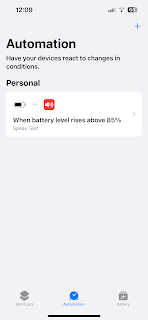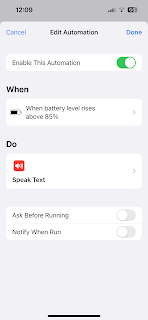Preserving Phone Battery
Introduction
Undoubtedly, the iPhone 14 is the most expensive phone I have ever owned.
- Consequently, I wish that it can last for as many as years as possible, but its battery inevitably degrade with use.
Tips to Preserve Phone Battery
I look up the internet for information on preserving battery life and extending battery lifespan.
Some practical tips include
- Enabling auto-brightness to prevent unnecessary power consumption.
- Managing background app refresh.
- Disabling location services, Bluetooth or mobile data when not needed
- Regularly updating software for battery optimization.
- Maintaining battery levels between 20% and 80% to avoid shutdowns or overcharging.
- Avoid charging or leaving the phone in hot environments for extended periods of time.
iPhone Battery Reminder Automation
To minimise the risk of forgetting to unplug iPhone once it reaches the desired charge, it is handy to set up an automation reminder.
- Open the Shortcuts app on your iPhone and tap Automation.
- Create a Personal Automation and select Battery Level.
- Choose the desired percentage for the reminder.
- Add an Action and select Speak Text.
- Type in the desired reminder message.
- Turn off Ask Before Running and leave Notify When Run blank.
NOTE: With iPhone 15 models, you can choose between Optimised Battery Charging, 80% Limit and None.
iPhone Battery Health
Battery health is a dedicated feature in iPhones that provides valuable information about the battery's current capacity and whether it needs servicing.
- This feature is not yet as standardized or readily available across all Android phones.
While some Android manufacturers and third-party apps offer similar functionality, it is often less consistent or comprehensive compared to the integrated solution on iPhones.
The Truth
All rechargeable lithium-ion batteries are consumable components that become less effective as they age, meaning they can hold less charge.- For example, a normal iPhone battery is designed to retain up to 80% of its original capacity at 500 complete charge cycles under normal conditions.
Hence, despite numerous online claims that promise 100% preservation after a year, I fervently believe this is only achievable with minimal phone usage.
- In light of this, it raises the question of why one should invest in a high-end phone if he is not using it.
- Hence, stop being paranoid and just enjoy your phone.
NOTE: Over time, a phone battery may become swollen, posing a serious safety hazard. Swelling indicates internal chemical reactions that can lead to battery rupture or even explosion, necessitating immediate action.
European Union Legislation
In recent years, newer smartphones have been offering only marginal upgrades over their predecessors.
- What often compel users to upgrade a new phone is not due to slowing processing speed or exciting features, but because of a failing battery.
- This legislation is a significant, positive step that empowers consumers to have more control over their devices and helps in reducing electronic waste.
Summary
Despite all the best practices for battery preservation, the battery will eventually degrade and need to be replaced.
- Hence, it is wise to buy a phone with a larger battery capacity, as this will give you more leeway even as the battery degrades over time.
However, the current phone annotation of battery capacity with mAh (milliampere-hours) is a simplification.
- Lithium-ion batteries in phones typically operate within a narrow voltage range of 3.7 to 4.2 volts. This consistency in voltage makes mAh a suitable measure for comparing battery capacities among different phone models.
- However, mWh (milliwatt-hours) provides a more accurate and informative measure of battery capacity. It directly measures the total energy stored in the battery, allowing for comparisons between batteries of different types and voltages.
- For example, a 12V battery with 1000 mAh has a higher energy capacity (12,000 mWh) than a 3.7V battery with the same mAh rating (3700 mWh).
- To illustrate, laptop batteries often utilize multiple lithium-ion cells connected in series. This configuration results in a higher overall voltage. A 4-cell battery, with each cell contributing approximately 3.7V, would have a nominal voltage of around 14.8V.
External Links
- iPhone battery and performance
- EU does it again! Apple might equip the iPhone with a replaceable battery by 2027, 2023
- Apple using cheaper batteries in iPhone 14 and 15 series that degrade more quickly says tipster, 2023
- iPhone 14, 14 Pro owners complain about battery capacity that’s already falling off, 2023


Comments
Post a Comment